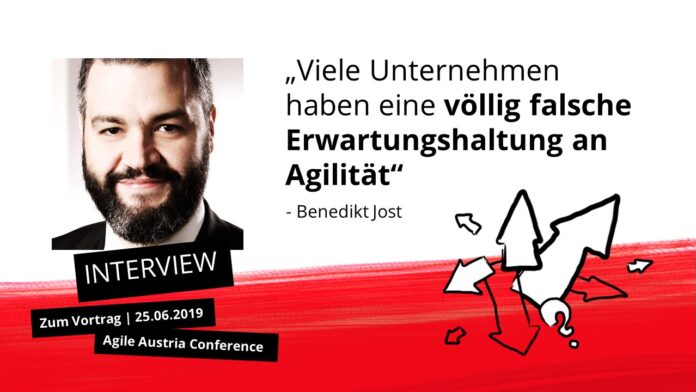In recent years, many companies have begun to move their organizations towards agility. Often, however, the expectations associated with this step were disappointed. Benedikt Jost, Manager at mgm consulting partners, explains why this is the case and what can be done about it on 25 June in his lecture “Agiler Mumpitz” at the Agile Austria Conference in Graz. We talked to him about the problem in advance.
Editor: Benedikt, at this year’s Agile Austria Conference you will give a lecture under the remarkable title “Agiler Mumpitz” (Agile Balderdash). What do you understand by that buzzword?
Benedikt Jost: I experience again and again that in many companies a completely wrong expectation of agility prevails. Many corporate decision-makers have now understood that classical organizational principles no longer function without restrictions in a dynamic environment and that agility can be the appropriate response to new challenges. But how an agile organization has to look like in order to actually be effective has not yet arrived in most people’s minds. Many CEOs believe that they only need to transform the prevailing stable state of their organization once into an agile model to achieve a new stable state in which they don’t need to change anything in the next 20 years. But if agility is interpreted in this way, it does not work. Then you will experience that although you do everything differently now, nothing has changed in essence. This is the “agile balderdash” I mentioned – although everything is painted in an agile way, the company is basically following the same path as before.
Editor: Why do many company managers lack the necessary understanding to design an effective agile transformation?
Benedikt Jost: There are several reasons for this. Many misunderstandings arise from the fact that agility at first glance seems like an easily understandable concept, the main features of which can be grasped in the twinkling of an eye. The temptation to understand agility only as a “small addition” to existing project management is therefore great. In fact, however, the concrete effects of the agile idea on real processes and structures are complex and difficult to penetrate. Without the necessary basic knowledge, initiatives therefore quickly run nowhere. In addition, many decision-makers and project managers have been in business for many years. During this time, they have gained a great deal of experience and have built up an extremely extensive knowledge of project management. It is understandably difficult for many managers to question and possibly even completely overcome this know-how, which is often acquired with great difficulty. The range of reactions then extends from sitting out the supposed “agile hype” to entanglement in exhausting retreat battles to attempting to enrich existing knowledge scantily with agile methods. However, none of these strategies is likely to lead to success.
Editorial team: Why are the persevering forces on the management floors so great? And why are they dangerous for companies?
Benedikt Jost: Most people prefer fixed structures with as few changes as possible. For example, when a trip is due, a large majority of people want to know where they will sleep in the evening. To want to plan things ahead and strive for stability is therefore something quite natural. Most corporate decision makers tick the same way: They want to achieve stable conditions in their organizations. In the vast majority of cases, however, the market environment is no longer stable and predictable, but dynamic, uncertain and complex. An organization that wants to be successful in this constellation must reflect these conditions. This means that it must constantly evolve and change. The result is a fluid organization that changes its shape time and again and adapts it to current requirements. It is no longer possible to grasp such an organization with classical organization charts.
Editor: Isn’t there a great danger that such an elusive organization will overwhelm decision-makers and employees?
Benedikt Jost: Yes. Therefore, this far-reaching change process in companies must be well accompanied. It is not only about the simple application of a “tool”, but rather about a gain of knowledge and a paradigm shift. In addition, an agile company also needs a framework and certain fixed points that do not change as frequently. Defining these fixed points is the big challenge. It is easier to determine what they are not. It’s not the processes within the company, because you want to constantly adapt and improve them to changes in the market environment. It’s not the teams either, because you want to mix them up again and again in order to facilitate exchange and collaboration. And it’s not the roles that employees fill. After all, it is possible for tasks to change and align with the market. But what’s left? One example among many is the so-called “Purpose” – this term stands for the fact that an organization has a common goal, a common purpose, a common sense. Within a company, people work together to achieve this goal. This common interest is part of the framework that holds the fluid organization together like a kind of invisible glue.
Editor: People who come together in a company to achieve a common higher goal – isn’t this idea very idealistic?
Benedikt Jost: It’s also a little bit related to the topic Purpose. A purpose in its purest form can be found, for example, in NGOs that have a clear goal – like cleaning the seas. How they achieve this goal ultimately doesn’t matter. They have a few fixed points, but within these fixed points they are fluid. But a common purpose also makes sense in commercial enterprises, because money alone cannot bait many employees in times of a shortage of skilled workers. The establishment of a value system that employees can stand behind and that encourages them to enjoy working for a company is therefore a necessity for today’s companies and not a pure idealism. Start-ups in particular usually have a clear purpose, which they pursue very flexibly and with great commitment.
Editing: Is the model of the agile organization at all transferable to larger enterprises in view of such requirements?
Benedikt Jost: Yes. On the one hand, classical organisations can also benefit from agility in their stable structures to a certain extent; however, they must create considerable degrees of freedom so that these agile initiatives can become effective. On the other hand, the large American tech companies, for example, have developed alternative organizational models to traditional companies. They work completely differently and, for example, say quite clearly: “Our purpose is to make our customers happy – and if we can do that, we also earn money.” That sounds trivial, but it’s a completely different model. This fixed point is the stable framework to which everything is subordinated and to which everything – processes, roles, teams, etc. – is constantly realigned. But you don’t have to look only to the USA. In Germany, too, many leading industrial companies talk quite differently about agility today than they did four or five years ago. There a lot has changed in the mindset and in the understanding of agility.
Editor: These mindset changes seem to be very tedious. You’re talking about several years yourself. Is the road to a functioning agile organization really so small?
Benedikt Jost: It’s not a revolution, it’s an evolution. By definition, evolution is slow – something is tried out and maybe even finished. In this way, a “learning organization” is created that is constantly evolving and changing. The task of corporate decision-makers is to create the framework conditions for this evolution – i.e. the fixed points we have talked about – and to review them again and again. Employees can, of course, be involved by defining things together: What do we currently stand for as a company? What do we stand for? Who are our customers and how do we make them happy? On this basis, the framework is created within which an agile organization is anchored and can unfold its effect.
Editor: Do you think this view of agility will become more widespread in the coming years?
Benedikt Jost: I believe that many companies are currently at a crossroads. In many organizations, agile initiatives have been launched in recent years with a lot of vigour and commitment. However, those responsible often find that these activities do not achieve the desired results. It is then often concluded within companies that agility does not work. Thus the concept is often completely aborted in these organizations. However, the organizations often do not come up with the idea that agility is not effective because the company has done something wrong – after all, they apparently fulfilled all the criteria: For example, they have hired Scrum Masters and Product Owners, converted the processes and worked iteratively and incrementally. Nevertheless, there was one crucial error of thought: if one believes that the change to an agile organization means moving from one stable state to the next, the transformation will not succeed. Drawing attention to this error of thought is currently the great challenge facing the agile community.
Editor: What task do you see yourself facing as an Agile Coach?
Benedikt Jost: In the past, we as agile coaches have concentrated very strongly on developing further sophisticated models. From my point of view, however, we have now reached a certain saturation of frameworks and methods – the “agile toolbox” is full. The task now is to not only explain these many different approaches theoretically, but to develop a strong vision of an agile organization together with the partners and colleagues in the companies and to transport it into the company. This requires good stories above all else. Stories that enable the listener to identify with the problem. Stories that convey strong images – and invite you to join in. I would like to present such a story to the visitors of the Agile Austria Conference.







